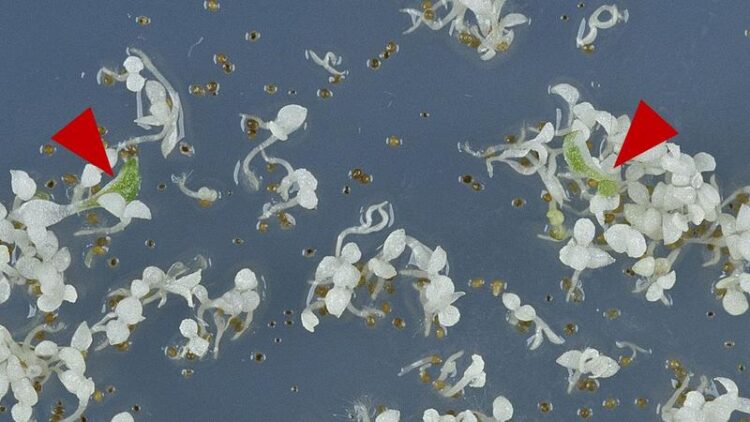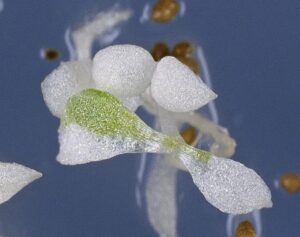1 billion years of abstinence: chloroplasts finally can hope for sex!

Tobacco seedlings on growth medium with an antibiotic. Plants with maternally inherited chloroplasts are pale. Two seedlings contain green chloroplasts (red arrows) that were passed on from the father plant and are resistant to the antibiotic.
(c) MPI-MP
Scientists at the Max Planck Institute of Molecular Plant Physiology in Potsdam (Germany) analyzed the inheritance of chloroplasts under different environmental conditions in almost 4 million tobacco plants.
Contrary to the prevailing view that chloroplasts are only passed on by the mother plant, paternal chloroplasts can also be transmitted to the offspring under cold conditions, raising the possibility that the chloroplasts of the two parents exchange genetic material with each other. The new findings will facilitate the targeted use of chloroplast-encoded traits in plant breeding, and they also open up new perspectives for evolutionary research. The study was published in Nature Plants.
A story of flowers and bees is the classic introduction to a topic that is still discussed far too scarcely in our society: sex in plants! When plants reproduce, the sperms within the pollen grains fuse with the egg cell within the flower the pollen has landed on. In this way, the genetic material of the cell nuclei of both parents is combined in the seed. This is important, as it allows harmful mutations to be purged that otherwise would accumulate in the genetic material over generations.
Chloroplasts have their own genetic material

(c) MPI-MP
In addition to the genetic material in the cell nucleus, mitochondria and chloroplasts also harbor genetic material. Mitochondria are the combustion engines of cells. Animal and plant cells use them to burn carbohydrates and utilize the released energy for their metabolism. Plants additionally have chloroplasts. They contain the green pigment chlorophyll, and are the solar power plants of the cells. The chloroplasts allow plants to collect solar energy in a process known as photosynthesis to produce carbohydrates.
Mitochondria and chloroplasts have their own genetic material, because they stem from bacteria that were taken up by the ancestors of modern animal and plant cells more than a billion years ago. Mitochondria and chloroplasts have established a symbiotic community within the cell, and the former roommates have now become indispensable for plant survival.
It is well known that the genomes of mitochondria and chloroplasts, unlike the genetic material in the cell nucleus, are not inherited equally from father and mother. Both are passed on almost exclusively by the mother, because they either do not enter the sperm at all, or their genetic material is degraded in the pollen. If mitochondria and chloroplasts from mother and father never meet, they cannot have sex to exchange genetic material. Therefore, harmful genetic mutations should accumulate over generations and eventually result in genome collapse.
Scientists evaluated nearly 4 million plants
Scientists at the Max Planck Institute of Molecular Plant Physiology have now discovered that, contrary to common belief, tobacco plants can routinely pass on chloroplasts from the father plant under certain environmental conditions. The researchers first created father plants with chloroplasts resistant to an antibiotic. These plants were then exposed to various environmental conditions such as heat, cold, drought and strong light during pollen maturation. Pollen from these plants was used to pollinate unmodified mother plants. The seeds produced from this cross were grown on a culture medium containing the appropriate antibiotic. Since only the paternal chloroplasts survive on this medium, cells containing chloroplasts from the father plant appear green, while the plants with only maternally inherited chloroplasts are pale, as these chloroplasts bleach out due to their sensitivity to the antibiotic.
Because paternally inherited chloroplasts are extremely rare, the scientists had to look at nearly 4 million seedlings to show that the proportion of paternally inherited chloroplasts was 150 times higher under cold treatment than under normal temperature. “It’s tough to stay motivated when you’re looking at thousands of seedlings, always searching for that one green spot. Accordingly, we were thrilled when the cold experiments actually showed a strong effect,” says Stephanie Ruf, one of the authors of the study.
Inheritance of chloroplasts can be manipulated
After this initial success, the researchers dug into the details: “We know that cold slows down the activity of enzymes. We thus suspected that an enzyme might be involved in blocking the paternal inheritance of chloroplasts,” comments Enrique Gonzalez-Duran, who was also involved in the study. The scientists selectively produced plants carrying a defective enzyme that normally degrades the genetic material of chloroplasts during pollen maturation. Plants with the defective enzyme also showed greatly increased paternal inheritance of chloroplasts. When combined, the enzyme defect and the cold application during pollen development led to a paternal inheritance rate of 2-3%. “This may not sound much, but it is gigantic compared to a 1 in 100,000 chance of this occurring under normal conditions. It will be very interesting to find out whether maternally and paternally inherited chloroplasts actually exchange genetic material with each other,” says Kin Pan Chung, another author of the study.
The finding that the inheritance of chloroplasts can be controlled by temperature and changes to individual enzymes in the plant opens up completely new possibilities for plant breeding. “Since it was previously thought that mitochondria and chloroplasts were always inherited together and only from the mother, there was no way to pass on the traits encoded in their genetic material separately. The possibility of transmitting chloroplasts also from the father by simply putting plants in the cold could open the door to completely new breeding programs,” explains Ralph Bock, the head of the research group. Why mitochondria and chloroplasts are largely inherited from the mother is still unclear. The fact that this type of inheritance can respond flexibly to environmental conditions will likely cause evolutionary biologists to rethink some of their current theories and models. “It also shows how important it is to take environmental conditions into account in genetic research. Chloroplasts led us to believe for decades that they lived sexually abstemious, but now we can’t be so sure anymore,” says Bock.
Wissenschaftliche Ansprechpartner:
Ralph Bock
Max Planck Institute of Molecular Plant Physiology
rbock@mpimp-golm.mpg.de
Originalpublikation:
Kin Pan Chung, Enrique Gonzalez-Duran, Stephanie Ruf, Pierre Endries & Ralph Bock
Control of plastid inheritance by environmental and genetic factors
Nature Plants, 16.01.2023, DOI: 10.1038/s41477-022-01323-7
link: https://www.nature.com/articles/s41477-022-01323-7
Media Contact
All latest news from the category: Life Sciences and Chemistry
Articles and reports from the Life Sciences and chemistry area deal with applied and basic research into modern biology, chemistry and human medicine.
Valuable information can be found on a range of life sciences fields including bacteriology, biochemistry, bionics, bioinformatics, biophysics, biotechnology, genetics, geobotany, human biology, marine biology, microbiology, molecular biology, cellular biology, zoology, bioinorganic chemistry, microchemistry and environmental chemistry.
Newest articles

Innovative 3D printed scaffolds offer new hope for bone healing
Researchers at the Institute for Bioengineering of Catalonia have developed novel 3D printed PLA-CaP scaffolds that promote blood vessel formation, ensuring better healing and regeneration of bone tissue. Bone is…

The surprising role of gut infection in Alzheimer’s disease
ASU- and Banner Alzheimer’s Institute-led study implicates link between a common virus and the disease, which travels from the gut to the brain and may be a target for antiviral…

Molecular gardening: New enzymes discovered for protein modification pruning
How deubiquitinases USP53 and USP54 cleave long polyubiquitin chains and how the former is linked to liver disease in children. Deubiquitinases (DUBs) are enzymes used by cells to trim protein…



